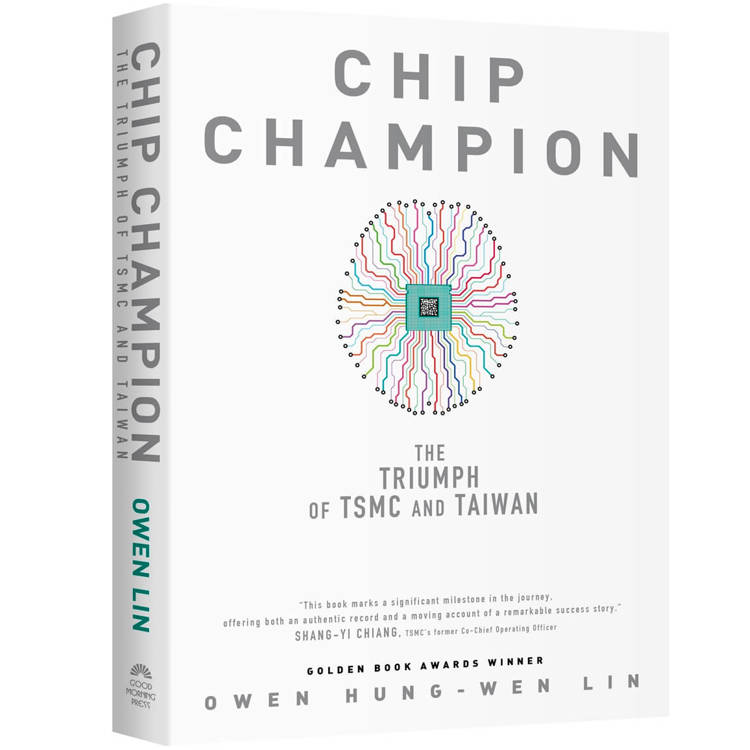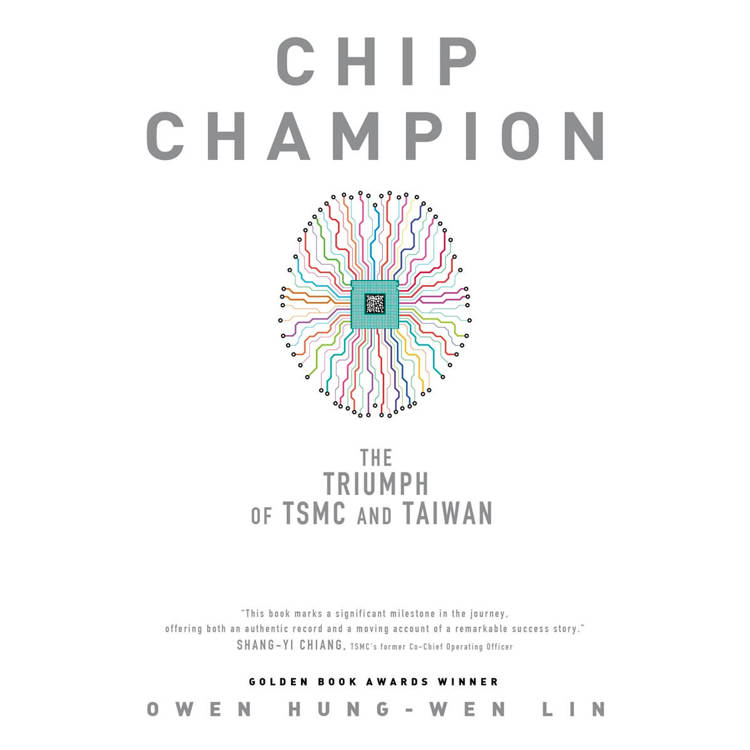Chip Champion:The Triumph of TSMC and Taiwan
活動訊息
內容簡介
Written by an award-winning journalist, Owen Hung-Wen Lin, whose deep expertise makes this book indispensable for anyone seeking to understand the forces shaping the digital age.
An authentic insider account of TSMC’s rise, based on more than 30 years of interviews with industry leaders, experts, and former employees.
Explores the strategic decisions, management philosophies, and cultural practices that enabled TSMC to surpass competitors like Intel and reshape the landscape of global technology competition.
Provides vital context for understanding semiconductor supply chains and their pivotal role in AI, geopolitics, and technological innovation—crucial for investors, business leaders, and policy makers.
Examines how TSMC navigates US–China tensions and international pressures while driving industry-changing innovation and consistent growth.
The Silicon Backbone of the Digital Age
“This book marks a significant milestone in the journey, offering both an authentic record and a moving account of a remarkable success story.”
Shang-Yi Chiang, TSMC’s former Co-Chief Operating Officer
“The author has witnessed numerous significant events in the semiconductor industry over the past thirty years … an indispensable read for anyone concerned with the industry.”
Stan Shih, Founder and Honorary Chairman of Acer Group
In a world increasingly defined by AI and technological innovation, one company stands at the critical nexus of global supply chains, geopolitical tensions, and cutting-edge engineering: TSMC.
Taiwan Semiconductor Manufacturing Company has emerged as the world’s indispensable manufacturer of advanced semiconductor chips—the unseen yet essential components powering everything from smartphones and laptops to data centers and autonomous vehicles.
How did a company founded in an island nation of 23 million people become the world’s most valuable semiconductor firm and the producer of approximately 90% of its most advanced chips? What management philosophies, strategic decisions, and cultural practices enabled TSMC to outpace the once-dominant Intel? And perhaps most critically, how does this Taiwanese company navigate the increasingly turbulent waters of US–China tensions while sustaining its remarkable trajectory of innovation and growth?
Chip Champion takes readers inside the remarkable story of TSMC's rise to global dominance. Drawing on more than 30 years of extensive interviews with industry insiders, employees, and semiconductor experts, it provides unprecedented insight into how a Taiwanese manufacturing pioneer transformed itself into one of the world's most essential companies—one whose products now touch virtually every aspect of modern life.
As nations around the world scramble to secure semiconductor supply chains and build domestic chip manufacturing capacity, understanding TSMC's triumph is essential not just for business leaders and technology enthusiasts, but for anyone seeking to comprehend the complex forces shaping our digital future.
An authentic insider account of TSMC’s rise, based on more than 30 years of interviews with industry leaders, experts, and former employees.
Explores the strategic decisions, management philosophies, and cultural practices that enabled TSMC to surpass competitors like Intel and reshape the landscape of global technology competition.
Provides vital context for understanding semiconductor supply chains and their pivotal role in AI, geopolitics, and technological innovation—crucial for investors, business leaders, and policy makers.
Examines how TSMC navigates US–China tensions and international pressures while driving industry-changing innovation and consistent growth.
The Silicon Backbone of the Digital Age
“This book marks a significant milestone in the journey, offering both an authentic record and a moving account of a remarkable success story.”
Shang-Yi Chiang, TSMC’s former Co-Chief Operating Officer
“The author has witnessed numerous significant events in the semiconductor industry over the past thirty years … an indispensable read for anyone concerned with the industry.”
Stan Shih, Founder and Honorary Chairman of Acer Group
In a world increasingly defined by AI and technological innovation, one company stands at the critical nexus of global supply chains, geopolitical tensions, and cutting-edge engineering: TSMC.
Taiwan Semiconductor Manufacturing Company has emerged as the world’s indispensable manufacturer of advanced semiconductor chips—the unseen yet essential components powering everything from smartphones and laptops to data centers and autonomous vehicles.
How did a company founded in an island nation of 23 million people become the world’s most valuable semiconductor firm and the producer of approximately 90% of its most advanced chips? What management philosophies, strategic decisions, and cultural practices enabled TSMC to outpace the once-dominant Intel? And perhaps most critically, how does this Taiwanese company navigate the increasingly turbulent waters of US–China tensions while sustaining its remarkable trajectory of innovation and growth?
Chip Champion takes readers inside the remarkable story of TSMC's rise to global dominance. Drawing on more than 30 years of extensive interviews with industry insiders, employees, and semiconductor experts, it provides unprecedented insight into how a Taiwanese manufacturing pioneer transformed itself into one of the world's most essential companies—one whose products now touch virtually every aspect of modern life.
As nations around the world scramble to secure semiconductor supply chains and build domestic chip manufacturing capacity, understanding TSMC's triumph is essential not just for business leaders and technology enthusiasts, but for anyone seeking to comprehend the complex forces shaping our digital future.
目錄
Acknowledgement
Introduction
I: STRATEGIC VISION
II: MANAGEMENT MASTERY
III: CORPORATE CULTURE
IV: INNOVATION ENGINE
V: GEOPOLITICAL CHESSBOARD
Conclusion
Epilogue
Introduction
I: STRATEGIC VISION
II: MANAGEMENT MASTERY
III: CORPORATE CULTURE
IV: INNOVATION ENGINE
V: GEOPOLITICAL CHESSBOARD
Conclusion
Epilogue
序/導讀
A Story of Vision, Innovation, and Collaboration
Taiwan Semiconductor Manufacturing Company, or “TSMC”, might not be a household name in America, but the chips it manufactures power nearly every aspect of our modern lives—from smartphones and computers to cars and artificial intelligence.
Located on Taiwan, a small island nation barely 100 miles off the coast of China, TSMC produces roughly 90% of the world's most advanced semiconductors—tiny silicon brains that power the modern world economy.
Taiwan’s technological dominance represents perhaps the most remarkable industrial achievement of the past half-century, as Taiwan moved up the value chain from manufacturing plastic toys and umbrellas into producing the most sophisticated technological components ever known. "We hold the modern world in our hands," a senior TSMC executive once said. "Though most people will never know our name."
How did this happen?
Taiwan has not taken away America's chip business
When US President Donald Trump declared that Taiwan had "taken about 100% of our chip business," he echoed a widespread misunderstanding of Taiwan's role in the semiconductor industry.
The reality is far more nuanced: Taiwan has not taken away America's chip business but has instead been a crucial enabler of its growth. By providing cutting-edge manufacturing capabilities, Taiwan—led by TSMC—has helped US technology giants to focus on innovation while maintaining their dominance in the global semiconductor ecosystem.
Taiwan's semiconductor industry has become indispensable to the global economy. TSMC alone controls over 90% of the advanced semiconductor manufacturing market, making it a linchpin for industries ranging from artificial intelligence to consumer electronics. Its dominance underscores Taiwan's outsized influence in the global tech landscape, a remarkable feat for a small island nation.
In recent years, the strategic importance of semiconductors has grown exponentially. Once viewed primarily as a driver of technological advancement, semiconductor technology is now at the heart of geopolitical tensions. Taiwan's leadership in this field has placed it at the center of global conflicts, making it essential for the world to understand how this island achieved such dominance.
A Personal Journey Through Taiwan’s Semiconductor Evolution
My journey as a journalist covering the semiconductor industry began in 1993. Over three decades, I have conducted countless interviews and analyzed industry trends, witnessing firsthand how Taiwan transformed from a modest player into a global leader in semiconductors. While books like Chris Miller's Chip War provide an excellent overview of semiconductor history from a US-Soviet Cold War perspective, this book aims to offer insights into how Taiwan and its high tech companies became tech powerhouses.
Taiwan's rise as a global leader in the semiconductor industry was no accident—it was the result of deliberate planning and strategic investments. The story begins in the 1970s when Taiwan was primarily known for low-tech exports like shoes and umbrellas. Recognizing the need to transform and to modernize its economy, far-sighted civic leaders identified semiconductors as a strategic sector.
Since then, the global semiconductor industry has undergone dramatic shifts. In the 1980s and 1990s, Japan emerged as America’s primary competitor, leading to intense trade disputes. South Korea later rose to prominence in memory chips, while China’s recent technological ambitions have added new dimensions to global competition.
Led by TSMC, Taiwan carved out its niche by focusing on integrated circuit design and manufacturing rather than competing directly with memory chip giants like Samsung. This specialization allowed Taiwanese companies to build expertise and establish themselves as indispensable players in global supply chains.
Recognizing the strategic importance of semiconductors, former US President Joe Biden championed the CHIPS Act—a $52 billion initiative aimed at reshoring chip manufacturing capabilities. However, replicating Taiwan’s success will require more than just financial investment; it will also demand long-term planning and collaboration between public and private sectors.
Challenges and Opportunities
Today, TSMC’s expansion beyond Taiwan reflects both opportunities and challenges. Its new fabs in Arizona and Japan aim to diversify production amid rising geopolitical risks but these initiatives face hurdles such as adapting management practices to local cultures and addressing higher operational costs.
These challenges highlight broader issues within the semiconductor industry as increasing product complexity places greater pressure on organizations and workers alike. Despite these obstacles, TSMC remains committed to maintaining its leadership position while contributing to global supply chain resilience.
The rise of artificial intelligence marks another transformative chapter for Taiwan’s semiconductor industry. NVIDIA CEO Jensen Huang has described Taiwan as "the world’s AI center," underscoring its pivotal role in enabling AI-driven innovations across sectors like healthcare and autonomous vehicles.
The collaboration between NVIDIA and TSMC also exemplifies how US-Taiwan partnerships can drive technological breakthroughs. Founded six years after TSMC, NVIDIA overcame significant challenges through resilience and innovation. Its close relationship with TSMC—rooted in mutual trust—offers valuable lessons for future international collaborations.
Chang’s leadership has been instrumental in shaping TSMC into a global powerhouse. His ability to navigate challenges—from early rejections by major international companies to fierce competition from rivals like Samsung—demonstrates his vision and perseverance.
Looking Ahead: Collaboration Amid Geopolitical Risks
Over the past 30 years, I have dedicated my career to covering the semiconductor and electronics industries, observing their evolution and identifying key factors that determine success.
As geopolitical tensions escalate, Taiwan’s success offers valuable lessons for countries seeking to develop their tech sectors. In my view, Taiwan’s transformation into a "chip island" is a testament to visionary leadership, strategic planning, and relentless innovation. As I reflect on three decades covering this remarkable story, I feel privileged to share these insights with readers worldwide.
This book aims to unravel the remarkable story behind TSMC's rise from a visionary startup founded in Taiwan into a global semiconductor powerhouse reshaping some of the world’s most critical industries. By exploring how this once-obscure Taiwanese company became indispensable to global technology supply chains—and why its massive investment has profound implications for America's future—we'll uncover lessons about strategic foresight, leadership, corporate culture, innovation and the effective management of geopolitical risk.
As TSMC reshapes the landscape of global technology through its historic US venture, understanding this company's story has never been more crucial or timely.
Taiwan Semiconductor Manufacturing Company, or “TSMC”, might not be a household name in America, but the chips it manufactures power nearly every aspect of our modern lives—from smartphones and computers to cars and artificial intelligence.
Located on Taiwan, a small island nation barely 100 miles off the coast of China, TSMC produces roughly 90% of the world's most advanced semiconductors—tiny silicon brains that power the modern world economy.
Taiwan’s technological dominance represents perhaps the most remarkable industrial achievement of the past half-century, as Taiwan moved up the value chain from manufacturing plastic toys and umbrellas into producing the most sophisticated technological components ever known. "We hold the modern world in our hands," a senior TSMC executive once said. "Though most people will never know our name."
How did this happen?
Taiwan has not taken away America's chip business
When US President Donald Trump declared that Taiwan had "taken about 100% of our chip business," he echoed a widespread misunderstanding of Taiwan's role in the semiconductor industry.
The reality is far more nuanced: Taiwan has not taken away America's chip business but has instead been a crucial enabler of its growth. By providing cutting-edge manufacturing capabilities, Taiwan—led by TSMC—has helped US technology giants to focus on innovation while maintaining their dominance in the global semiconductor ecosystem.
Taiwan's semiconductor industry has become indispensable to the global economy. TSMC alone controls over 90% of the advanced semiconductor manufacturing market, making it a linchpin for industries ranging from artificial intelligence to consumer electronics. Its dominance underscores Taiwan's outsized influence in the global tech landscape, a remarkable feat for a small island nation.
In recent years, the strategic importance of semiconductors has grown exponentially. Once viewed primarily as a driver of technological advancement, semiconductor technology is now at the heart of geopolitical tensions. Taiwan's leadership in this field has placed it at the center of global conflicts, making it essential for the world to understand how this island achieved such dominance.
A Personal Journey Through Taiwan’s Semiconductor Evolution
My journey as a journalist covering the semiconductor industry began in 1993. Over three decades, I have conducted countless interviews and analyzed industry trends, witnessing firsthand how Taiwan transformed from a modest player into a global leader in semiconductors. While books like Chris Miller's Chip War provide an excellent overview of semiconductor history from a US-Soviet Cold War perspective, this book aims to offer insights into how Taiwan and its high tech companies became tech powerhouses.
Taiwan's rise as a global leader in the semiconductor industry was no accident—it was the result of deliberate planning and strategic investments. The story begins in the 1970s when Taiwan was primarily known for low-tech exports like shoes and umbrellas. Recognizing the need to transform and to modernize its economy, far-sighted civic leaders identified semiconductors as a strategic sector.
Since then, the global semiconductor industry has undergone dramatic shifts. In the 1980s and 1990s, Japan emerged as America’s primary competitor, leading to intense trade disputes. South Korea later rose to prominence in memory chips, while China’s recent technological ambitions have added new dimensions to global competition.
Led by TSMC, Taiwan carved out its niche by focusing on integrated circuit design and manufacturing rather than competing directly with memory chip giants like Samsung. This specialization allowed Taiwanese companies to build expertise and establish themselves as indispensable players in global supply chains.
Recognizing the strategic importance of semiconductors, former US President Joe Biden championed the CHIPS Act—a $52 billion initiative aimed at reshoring chip manufacturing capabilities. However, replicating Taiwan’s success will require more than just financial investment; it will also demand long-term planning and collaboration between public and private sectors.
Challenges and Opportunities
Today, TSMC’s expansion beyond Taiwan reflects both opportunities and challenges. Its new fabs in Arizona and Japan aim to diversify production amid rising geopolitical risks but these initiatives face hurdles such as adapting management practices to local cultures and addressing higher operational costs.
These challenges highlight broader issues within the semiconductor industry as increasing product complexity places greater pressure on organizations and workers alike. Despite these obstacles, TSMC remains committed to maintaining its leadership position while contributing to global supply chain resilience.
The rise of artificial intelligence marks another transformative chapter for Taiwan’s semiconductor industry. NVIDIA CEO Jensen Huang has described Taiwan as "the world’s AI center," underscoring its pivotal role in enabling AI-driven innovations across sectors like healthcare and autonomous vehicles.
The collaboration between NVIDIA and TSMC also exemplifies how US-Taiwan partnerships can drive technological breakthroughs. Founded six years after TSMC, NVIDIA overcame significant challenges through resilience and innovation. Its close relationship with TSMC—rooted in mutual trust—offers valuable lessons for future international collaborations.
Chang’s leadership has been instrumental in shaping TSMC into a global powerhouse. His ability to navigate challenges—from early rejections by major international companies to fierce competition from rivals like Samsung—demonstrates his vision and perseverance.
Looking Ahead: Collaboration Amid Geopolitical Risks
Over the past 30 years, I have dedicated my career to covering the semiconductor and electronics industries, observing their evolution and identifying key factors that determine success.
As geopolitical tensions escalate, Taiwan’s success offers valuable lessons for countries seeking to develop their tech sectors. In my view, Taiwan’s transformation into a "chip island" is a testament to visionary leadership, strategic planning, and relentless innovation. As I reflect on three decades covering this remarkable story, I feel privileged to share these insights with readers worldwide.
This book aims to unravel the remarkable story behind TSMC's rise from a visionary startup founded in Taiwan into a global semiconductor powerhouse reshaping some of the world’s most critical industries. By exploring how this once-obscure Taiwanese company became indispensable to global technology supply chains—and why its massive investment has profound implications for America's future—we'll uncover lessons about strategic foresight, leadership, corporate culture, innovation and the effective management of geopolitical risk.
As TSMC reshapes the landscape of global technology through its historic US venture, understanding this company's story has never been more crucial or timely.
配送方式
-
台灣
- 國內宅配:本島、離島
-
到店取貨:
不限金額免運費



-
海外
- 國際快遞:全球
-
港澳店取:


訂購/退換貨須知
退換貨須知:
**提醒您,鑑賞期不等於試用期,退回商品須為全新狀態**
-
依據「消費者保護法」第19條及行政院消費者保護處公告之「通訊交易解除權合理例外情事適用準則」,以下商品購買後,除商品本身有瑕疵外,將不提供7天的猶豫期:
- 易於腐敗、保存期限較短或解約時即將逾期。(如:生鮮食品)
- 依消費者要求所為之客製化給付。(客製化商品)
- 報紙、期刊或雜誌。(含MOOK、外文雜誌)
- 經消費者拆封之影音商品或電腦軟體。
- 非以有形媒介提供之數位內容或一經提供即為完成之線上服務,經消費者事先同意始提供。(如:電子書、電子雜誌、下載版軟體、虛擬商品…等)
- 已拆封之個人衛生用品。(如:內衣褲、刮鬍刀、除毛刀…等)
- 若非上列種類商品,均享有到貨7天的猶豫期(含例假日)。
- 辦理退換貨時,商品(組合商品恕無法接受單獨退貨)必須是您收到商品時的原始狀態(包含商品本體、配件、贈品、保證書、所有附隨資料文件及原廠內外包裝…等),請勿直接使用原廠包裝寄送,或於原廠包裝上黏貼紙張或書寫文字。
- 退回商品若無法回復原狀,將請您負擔回復原狀所需費用,嚴重時將影響您的退貨權益。















商品評價